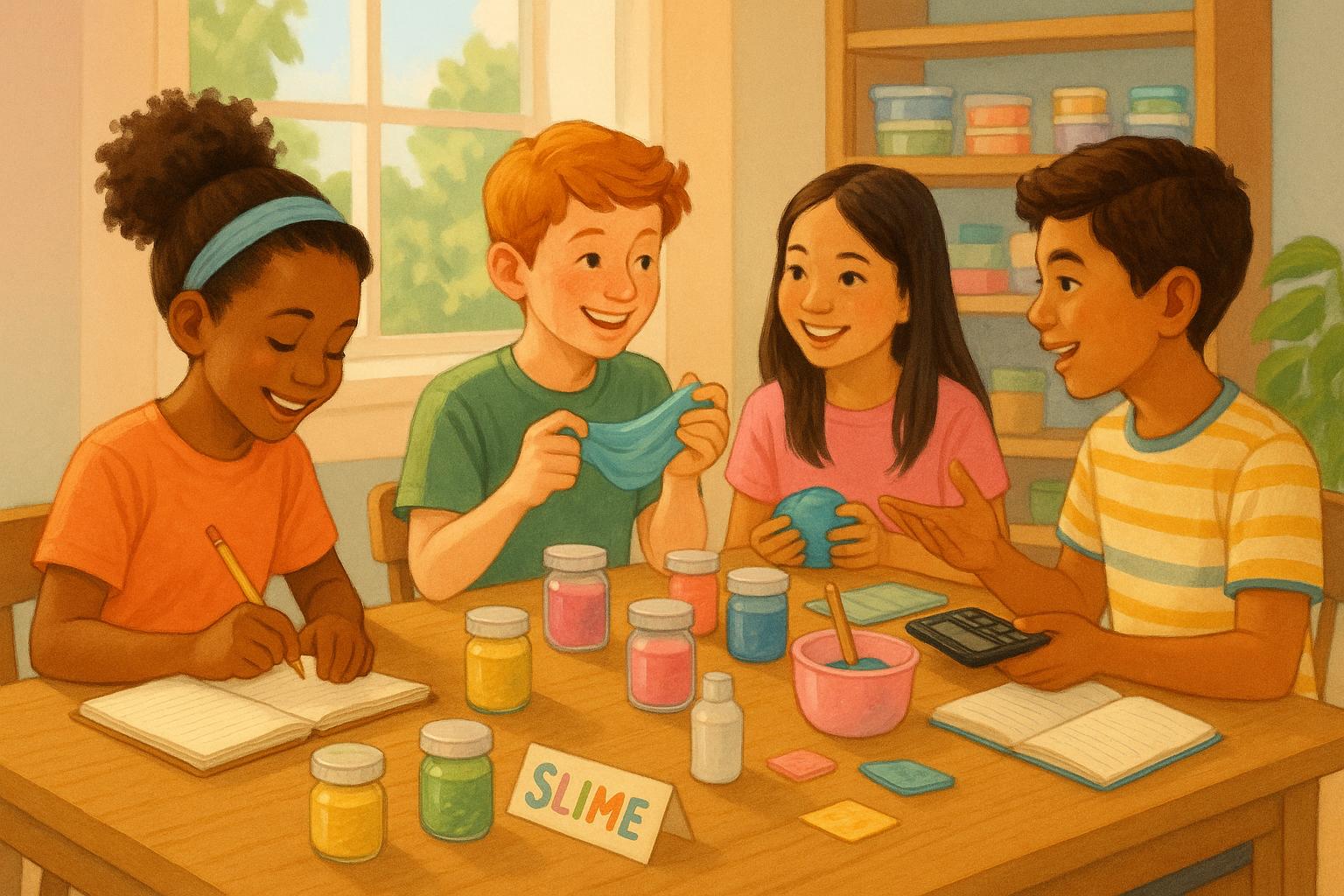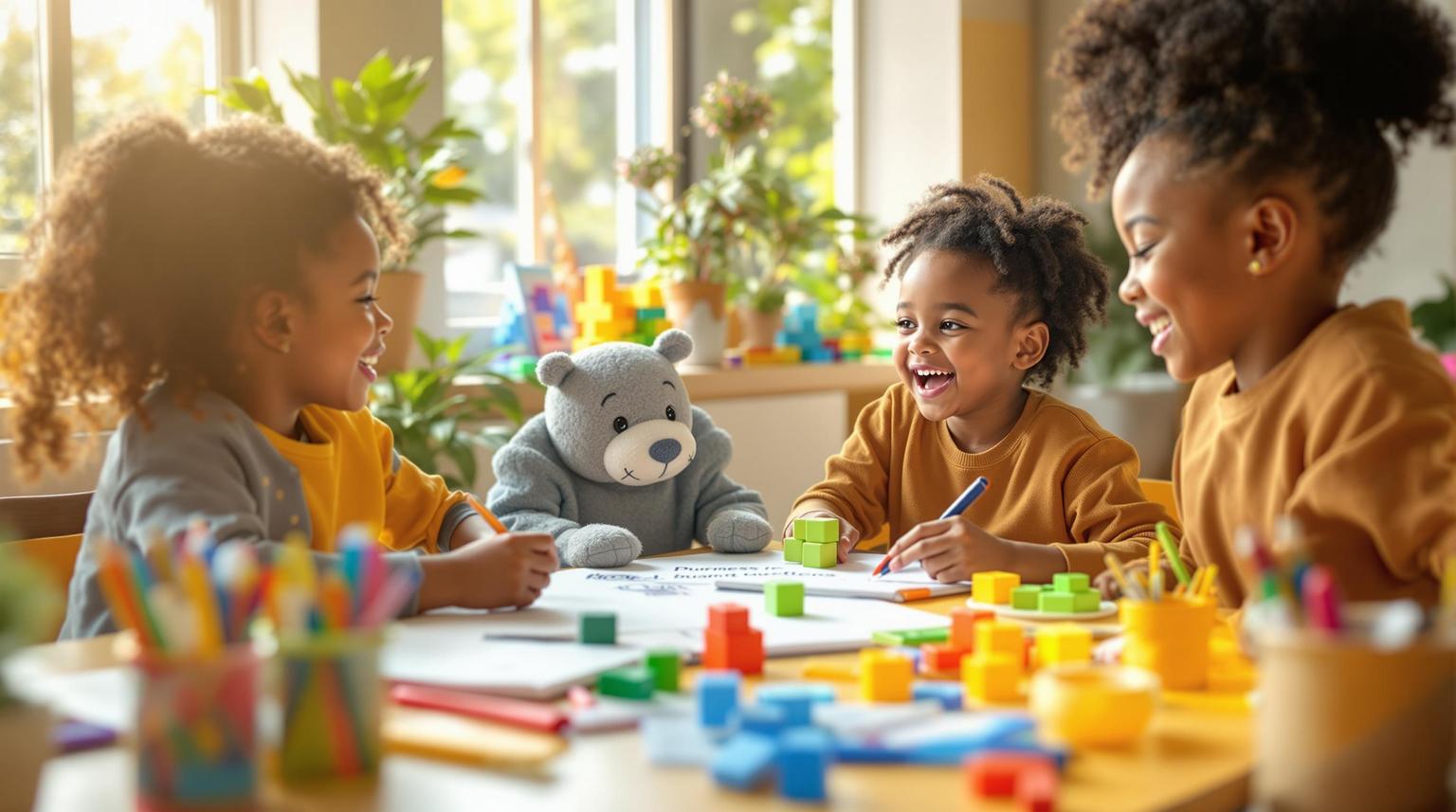Want to keep your kids engaged without screens? Here are 5 hands-on activities that are fun, educational, and easy to set up with everyday materials:
-
Start a Slime Business
Kids can make and sell slime while learning basic business skills like budgeting, marketing, and customer service. Kits start at $39.95. -
Build a Science Volcano
Create a mini volcano with baking soda and vinegar for a fun chemistry experiment. Costs around $10-$15. -
Design with Cardboard Boxes
Turn cardboard into castles, mazes, or dollhouses. Great for sparking creativity and problem-solving. Free or low-cost. -
Create a Custom Board Game
Design your own board game with poster boards, dice, and markers. Encourages strategic thinking and storytelling for $5-$20. -
Plan a Local Treasure Hunt
Organize a scavenger hunt with riddles, maps, and clues. Perfect for outdoor fun and teamwork. Costs $0-$10.
Quick Comparison
| Activity | Time Needed | Mess Level | Location | Age Range | Materials Cost |
|---|---|---|---|---|---|
| Slime Business | 1-2 hours | Medium | Indoor/Outdoor | 6-12 years | $39.95+ |
| Science Volcano | 45-60 mins | High | Outdoor | 7+ years | $10-$15 |
| Cardboard Design | 1-3 hours | Low | Indoor | 4+ years | Free-$5 |
| Custom Board Game | 2-4 hours | Low | Indoor | 8+ years | $5-$20 |
| Treasure Hunt | 1-2 hours | Low | Indoor/Outdoor | 3+ years | $0-$10 |
These activities help kids develop problem-solving, critical thinking, and social skills - all while having fun. Pick one to try today!
KidPreneur Brand Building DIY Ideas | Kid Entrepreneur Ideas ...
Benefits of Hands-On Learning Without Screens
When kids participate in physical activities away from screens, they gain important skills through direct interaction and active participation. These hands-on experiences engage multiple senses, helping improve memory retention. Let’s look at how this approach supports physical, cognitive, and social growth.
Physical Development and Problem-Solving
Hands-on activities help kids improve fine motor skills through precise movements. They learn to coordinate actions while tackling real-world factors like weight, balance, and structure - lessons that often get overlooked during passive screen time.
Critical Thinking Through Experience
These activities also encourage independent problem-solving, which helps kids develop critical thinking skills. Dr. Jody Sherman LeVos, Chief Learning Officer at Begin, explains:
"When children are allowed to figure things out independently, they learn how to think critically and develop solutions."
This skill becomes even more important when resources are limited. Kids learn to think creatively, experimenting with materials in unexpected ways or adjusting plans to work with what’s available.
Social Skills and Collaboration
Beyond individual growth, hands-on activities encourage teamwork. By working on group projects, solving problems together, and communicating in real-time, children learn essential social skills like compromise, conflict resolution, and collaboration.
Better Learning Retention
Physical engagement makes lessons stick. In SmartLab Learning environments, students work together on hands-on challenges - like creating mock governments or designing solutions to real-world issues. These activities not only teach critical teamwork skills but also prepare them for future careers.
Bill Laurienti, Content Marketing Manager at Creative Learning Systems, highlights this point:
"By engaging with materials and concepts firsthand, students develop a deeper understanding and a lasting enthusiasm for learning."
Learning Through Mistakes
Unlike screen-based activities where mistakes can be undone with a click, physical projects teach kids to embrace errors as part of the learning process. Trial and error builds perseverance, creativity, and adaptability. Encouraging reflection instead of quick fixes helps kids become better problem-solvers.
These benefits combine to create a rich, screen-free learning environment that prepares kids for creative and practical challenges.
1. Start a Slime Business with My Lil Startup

Turn screen time into hands-on fun by helping kids launch their own slime business. The My Lil Startup Slime Business Kit comes with everything needed to create and sell slime, including safe, non-toxic ingredients for 20 different slime varieties. It also includes decorative items like glitter, charms, and beads to make each product unique. To top it off, the kit provides marketing flyers, thank-you cards, and a sales tracker to teach young entrepreneurs how to manage their business.
What's Inside the Kit
The Slime Business Box is packed with tools to help kids create and sell slime. Here’s what they’ll get:
- Materials to make 20 slimes, plus glitter, charms, and beads for customization.
- Business tools like marketing flyers, thank-you cards, and a sales tracker to organize and grow their venture.
This kit equips kids with both creative supplies and practical tools to kickstart their small business.
Learning Through Doing
This activity goes beyond just making slime - it’s a fun way to build real-world skills. While experimenting with recipes and decorations, kids naturally develop:
- Product development by trying out different combinations.
- Basic accounting through tracking materials and sales.
- Marketing skills by designing product displays and promotions.
- Customer service during transactions.
- Entrepreneurial know-how gained through hands-on experience.
This kit blends creativity with practical lessons, making it an engaging introduction to business.
"Our mission is to help kids start their own businesses and go on to make a positive impact on the world." - My Lil Startup
Earning Made Easy
The kit includes step-by-step instructions that guide kids through the entire process - from creating slime to making their first sale. With these tools, children can earn their first $100 while learning valuable lessons along the way.
Choose the Right Kit for Your Needs
| Bundle Type | Price | Contents | Best For |
|---|---|---|---|
| Starter Kit | $39.95 | Supplies for 20 slimes, marketing materials | New entrepreneurs |
| Growth Bundle | $59.95 | Starter Kit + professional tablecloth | Kids ready for craft fairs |
| Mogul Bundle | $99.95 | Growth Bundle + materials for 40 more slimes | Serious young business owners |
This kit was created by a father-daughter duo after their daughter earned over $100 in just one hour selling slime. It’s a fun and profitable alternative to traditional activities like lemonade stands, proving how the right idea can make entrepreneurship exciting and rewarding for kids.
2. Build a Science Volcano
Transform your kitchen into a mini science lab where kids can create and decorate their own volcano - and watch it erupt!
Materials Needed
| Essentials | Extras for Creativity |
|---|---|
| Small plastic bottle | Food coloring |
| Baking soda | Paint |
| White vinegar | Small rocks |
| Liquid dish soap | Sand |
| Modeling clay or playdough | Dry yeast |
| Large tray | Decorative items |
| Safety goggles | - |
How to Build Your Volcano
Start by placing the plastic bottle on a large tray to catch any spills. Use modeling clay or playdough to shape a volcano around the bottle, making sure the bottle's opening stays uncovered. Want to add some flair? Use paint, rocks, or sand to make it look more realistic.
How to Create the Eruption
- Fill the bottle halfway with warm water.
- Add 3-4 drops of food coloring.
- Mix in a small squirt of dish soap.
- Add 2 tablespoons of baking soda.
- Slowly pour in vinegar and watch the eruption!
"This experiment simulates a volcanic eruption through a chemical reaction between baking soda (a base) and vinegar (an acid)." – funtastiklabs.com
What’s Happening?
The reaction between baking soda and vinegar creates carbonic acid, which quickly breaks down into water and carbon dioxide gas. The gas builds up, forcing the mixture out of the bottle in a foamy eruption. Dish soap amplifies the effect, creating even more bubbles and foam for a dramatic display.
Tips for an Even Better Experience
Stay Safe: Use safety goggles and make sure an adult is supervising.
Boost the Fun:
- Add a spoonful of dry yeast to the vinegar for a bigger, foamier eruption.
- Mix different food coloring combinations for custom lava colors.
- Experiment with varying amounts of baking soda and vinegar to see how it changes the eruption.
Make It a Learning Moment:
- Ask kids to predict the outcome before starting.
- Encourage them to write down or draw their observations.
- Compare this experiment to real volcanic eruptions and discuss the differences.
This exciting activity combines fun and learning, sparking curiosity and creativity while keeping kids engaged without screens.
3. Design with Cardboard Boxes
Turn ordinary cardboard boxes into engaging projects that encourage kids to think critically and solve problems. Building with cardboard not only sparks creativity but also provides a hands-on way to tackle challenges.
Materials Needed
| Must-Have Items | Optional Extras |
|---|---|
| Cardboard boxes (varied sizes) | Paint or markers |
| Scissors (adult supervision) | Fabric scraps |
| Packing tape | Stickers |
| Box cutter (adult use only) | Construction paper |
| Ruler or measuring tape | Decorative tape |
| Pencil | Natural materials |
Project Ideas by Age Group
Ages 3-5:
- Build a playhouse with a door and windows.
- Craft a car complete with a steering wheel.
- Set up a puppet theater for storytelling.
Ages 6-8:
- Design a multi-room dollhouse.
- Create a store front with shelves for pretend play.
- Construct a castle with a working drawbridge.
Ages 9-12:
- Build a marble maze that challenges precision.
- Make a pinhole camera to explore light and photography.
- Design a racetrack system for toy cars or marbles.
Building Tips for Success
Safety First: Adults should handle all cutting tools and ensure sharp edges are taped over. Keep the workspace organized and free of hazards.
Construction Tips:
- Reinforce the bottom corners to create a solid base.
- Score the cardboard along fold lines for cleaner bends.
- Strengthen joints by taping both sides for durability.
Making It Educational
Enhance the learning experience by incorporating these skills:
Math Skills:
- Measure dimensions accurately.
- Plan layouts and shapes.
- Experiment with symmetrical designs.
Engineering Basics:
- Test how strong structures are.
- Balance weight for stability.
- Explore simple physics principles.
Creative Problem-Solving:
- Design spaces that serve specific purposes.
- Solve stability issues creatively.
- Adjust designs based on available materials.
Advanced Challenges
For kids ready to take it to the next level, try building:
- A complex marble run.
- An elaborate castle with a functional drawbridge.
- A detailed, multi-level dollhouse.
Storage and Maintenance
Keep your creations in good shape by:
- Storing them in dry, safe areas.
- Reinforcing areas prone to wear and tear.
- Adding extra supports where needed.
- Applying a clear sealant to protect the surface.
sbb-itb-a46f019
4. Create a Custom Board Game
Turn your ideas into a fun tabletop game by designing and building your own board game. This hands-on activity encourages strategic thinking and planning while sparking creativity.
Materials You'll Need
| Basic Supplies | Game Components | Extras |
|---|---|---|
| Poster board/cardboard | Dice or spinner | Colored paper |
| Markers and pencils | Game pieces | Stickers |
| Ruler | Cards (index cards) | Paint |
| Scissors | Timer | Decorative tape |
| Glue | Storage container | Clear contact paper |
How to Design Your Game
Start by studying your favorite board games to figure out what makes them fun and engaging. Think about including a mix of chance and strategy. This way, both kids and adults can enjoy the game equally. As Meg from The Many Little Joys shared:
"My oldest son said, 'LUCK, because then the adults don't have the advantage over the kids.'"
Picking a Theme
Choose a theme that inspires you. Here are some ideas:
- Books or movies
- Family adventures
- Educational subjects
- Fantasy worlds
- Historical events
Steps to Build Your Board Game
-
Plan the Layout
- Decide on a starting and finishing point.
- Map out paths, special spaces, and obstacles.
- Add challenge zones to keep things interesting.
-
Design the Board
- Reinforce edges with tape for durability.
- Add a protective coating to preserve your work.
- Clearly mark spaces and paths.
- Include easy-to-follow instructions.
-
Set the Rules
- Outline how players will move.
- Decide what happens on special spaces.
- Define winning conditions.
- Think about how players will interact.
- Add challenges to make it fun and dynamic.
Once your game is ready, test it out with family or friends. Use their feedback to tweak the rules and improve the experience.
Why It’s More Than Just Play
Creating a board game isn’t just fun - it’s a great way to build problem-solving and storytelling skills. As Laura Miller, publisher of Macaroni Kid Appleton-Waupaca-Oshkosh, explains:
"Creating a board game is a great way to work on an (offline!) project. Making your own board game takes kids back to the basics of imaginative play, storytelling, and creativity. Plus - and this is a big bonus - it will keep a kid busy and engaged for a good long time."
Testing and Improving
Laura Miller shared how her 10-year-old daughter created a game based on The Evolution of Calpurnia Tate. After a few test runs, they realized players were finishing the game too quickly. Adjustments were made, and the gameplay improved significantly.
Adjusting for Different Ages
For Ages 5-7:
- Simple paths and rules
- Basic counting or shapes
- Picture-based instructions
For Ages 8-12:
- More complex strategies
- Multiple paths to the finish
- Challenge or action cards
- Detailed storylines
This project combines fun and learning, making it a hit for all ages!
5. Plan a Local Treasure Hunt
Transform your neighborhood into an exciting adventure with a well-thought-out treasure hunt. This activity combines movement, problem-solving, and creativity, offering kids a hands-on way to learn and have fun.
Setup and Planning
Start by picking a theme that sparks curiosity and excitement. Some ideas include:
- Pirate adventures
- Detective mysteries
- Nature exploration
- Historical quests
Once you’ve chosen a theme, follow these steps:
- Map out a safe, easy-to-follow route.
- Design clues that match the kids' age group.
- Prepare a fun “treasure” for the finish line.
- Test the route to ensure everything works smoothly.
- Set clear boundaries to keep the activity safe.
Age-Appropriate Clues
Tailor the clues to match the age and abilities of the participants. Here's a quick guide:
| Age Group | Clue Types | Examples |
|---|---|---|
| Ages 3–6 | Simple drawings, pictures | Shapes or familiar objects |
| Ages 7–9 | Basic written clues, rhymes | Short riddles or directions |
| Ages 10+ | Puzzles, word scrambles | Multi-step challenges, maps |
Making Clues Fun and Educational
Studies show that scavenger hunts can boost problem-solving and social skills. Here are some ideas for crafting engaging clues:
-
Riddles
Incorporate creative riddles to make kids think."I have keys but no locks. I have space but no room. You can enter, but you can't go inside. What am I?" (Answer: A keyboard)
-
Maps
Use simple treasure maps with landmarks. Mark an “X” to teach navigation and spatial skills. -
Physical Tasks
Add challenges like counting steps between locations or following basic compass directions to keep kids active.
Safety First
Before the big day, double-check these details to ensure everything runs smoothly:
- Scout the route for safety and accessibility.
- Check the weather forecast.
- Place clues at reachable heights.
- Make sure the route is visible and easy to supervise.
This treasure hunt is not just about fun - it’s a way to engage kids in problem-solving, teamwork, and physical activity, all while creating lasting memories.
Activity Quick Reference Guide
Here's a quick comparison of activities to help you decide which fits your needs best.
| Activity | Time Needed | Mess Level | Location | Age Range | Materials Cost |
|---|---|---|---|---|---|
| Slime Business | 1-2 hours | Medium | Indoor/Outdoor | 6-12 years | $39.95 (Starter Kit) |
| Science Volcano | 45-60 mins | High | Outdoor | 7+ years | $10-15 |
| Cardboard Design | 1-3 hours | Low | Indoor | 4+ years | Free-$5 |
| Custom Board Game | 2-4 hours | Low | Indoor | 8+ years | $5-20 |
| Treasure Hunt | 1-2 hours | Low | Indoor/Outdoor | 3+ years | $0-10 |
Activity Notes
Slime Business
- Encourages entrepreneurial thinking.
- Adult supervision is a must.
- Protect surfaces to avoid mess.
- Expand options with the Growth Bundle ($59.95).
Science Volcano
- Perfect for warm days.
- Cleanup needs to happen right away.
- Best done on grass or concrete to manage spills.
Cardboard Design
- Great for rainy days.
- Minimal mess to clean up.
- Needs some storage space for materials.
- Perfect for projects that span multiple days.
Custom Board Game
- Sparks creative problem-solving.
- Can be done over multiple sessions.
- Doubles as a reusable family activity.
- Adds fun to family game nights.
Treasure Hunt
- Works in any weather.
- Requires some planning ahead.
- Can be adjusted for different age groups.
- Fun for group activities.
Weather Considerations
If the weather isn’t cooperating, try these indoor alternatives:
- Turn outdoor treasure hunts into indoor mystery games.
- Set up cardboard design stations inside.
- Use the dining table as a workspace for board game creation.
- Plan strategies for the slime business indoors.
Making Activities Work for Your Family
Building on the earlier activity instructions, these tips help adjust each project to fit your family's needs while ensuring both learning and safety.
Adjusting for Different Ages
For younger children (ages 3–5):
- Break tasks into simple, step-by-step instructions.
- Use larger materials and focus on basic ideas like colors and shapes.
- Keep a close eye on them during more challenging activities.
For older kids (ages 8–12):
- Increase the complexity of projects (e.g., add detailed game rules or introduce basic business concepts).
- Encourage them to solve problems independently.
- Give them room to explore their own creative ideas.
These adjustments help create a safe and engaging experience for everyone.
Prioritizing Safety
- Always supervise activities that involve any risks.
- Keep craft supplies stored securely when not in use.
- Set up workspaces away from eating areas.
- Include designated cleanup spots to maintain order.
Turning Activities Into Learning Moments
Every activity offers a chance to learn something new. Here's a quick breakdown:
| Activity | Learning Opportunities |
|---|---|
| Slime Business | Budgeting, basic math, marketing concepts |
| Board Game | Strategic thinking, creativity, problem-solving |
| Treasure Hunt | Teamwork, critical thinking, observation skills |
| Cardboard Design | Engineering basics, motor skills development |
| Volcano | Scientific exploration, safety awareness |
Working in Groups
The way you organize groups can boost collaboration and reinforce skills.
Small groups (2–3 kids):
- Assign specific roles to each child.
- Create teams based on tasks.
- Let kids teach each other.
Larger groups (4+ kids):
- Set up multiple activity stations.
- Organize friendly competitions to keep things fun.
- Use rotation schedules to ensure everyone participates.
Tips for Business Activities
The My Lil Startup Slime Business Kit gives kids a chance to learn real-world skills like:
- Calculating costs and pricing products.
- Designing appealing product displays.
- Tracking inventory effectively.
- Practicing customer service.
- Managing simple budgets.
Adapting to Your Space
For indoor spaces:
- Designate specific craft areas.
- Use materials that are easy to clean.
- Protect surfaces from spills or messes.
- Consider mobile workstations for flexibility.
For outdoor spaces:
- Take advantage of natural light.
- Choose materials that can handle outdoor conditions.
- Set up easy-to-access cleanup stations.
- Keep an eye on weather changes to avoid disruptions.
Next Steps
Turn screen time into hands-on learning opportunities. Set aside regular screen-free days to make room for activities that spark creativity and curiosity. These ideas build on earlier suggestions to help you easily add interactive learning into your daily routine.
"Improving analytical and creative thinking develops the habits of imagining, experimenting, and questioning, and builds internal tools within our children to evaluate the world around them."
Here’s how to create an inviting space for learning:
- Set up a craft area with easy-to-clean surfaces
- Create a cozy reading nook
- Organize materials for easy access
- Start with short, 15-minute activities to ease into the routine
Boost engagement with these activity ideas:
| Time of Day | Activity Suggestion | Learning Focus |
|---|---|---|
| Morning | Science experiments | Critical thinking |
| After school | Start a slime business | Entrepreneurship |
| Evening | Family board games | Strategic planning |
| Weekends | Treasure hunts | Problem-solving |
Consistency is key. Consider starting with the $39.95 Starter Kit to blend creativity with practical business skills. Plan regular family activity nights to make these habits stick.
To keep things exciting:
- Rotate materials and try new activities
- Start small and celebrate progress along the way
- Adjust based on what works best for your family
Hands-on learning can help your children grow in so many ways. Your next screen-free adventure is just around the corner!
FAQs
What steps can I take to keep my child safe during these creative, hands-on activities?
Ensuring your child's safety during hands-on activities is simple with a few precautions. Always supervise them, especially when using tools like scissors, glue guns, or small objects. Keep hazardous materials such as sharp items, chemicals, or choking hazards out of reach.
Teach your child basic safety rules, like handling tools carefully or cleaning up spills promptly. Set up a well-lit, clutter-free workspace to minimize accidents. Most importantly, stay engaged - your presence not only ensures safety but also enhances the fun and learning experience!
How can I encourage my child to enjoy screen-free activities if they’re hesitant at first?
If your child is hesitant about screen-free activities, start by creating a positive and fun environment. Involve them in choosing the activity - giving them a say can make them feel more excited and in control. You can also join in the activities yourself, like building a DIY project or playing a hands-on game together, to show them how enjoyable it can be.
Another approach is to set clear and consistent boundaries around screen time, such as designating certain areas of your home as screen-free zones (like the dining room) or setting specific times for screens to be off. Make the transition gradual by introducing short, engaging activities that align with their interests, like crafting, cooking, or outdoor exploration. Positive reinforcement, like praise or small rewards, can also help motivate them to embrace these new routines.
How can I make these activities more educational and engaging for my child?
To make these activities more educational, try incorporating fun challenges or questions that encourage learning. For example, while setting up a DIY laser maze, you could ask your child to solve simple math problems or spell words correctly before moving to the next section. This adds an interactive learning element to the activity.
Storytelling is another great way to boost creativity and language skills. Encourage your child to create their own story while crafting or playing, helping them develop self-expression and imagination. Similarly, homemade puzzles or brainteasers are excellent tools for improving problem-solving and critical thinking skills. By blending learning with play, you can keep your child entertained while fostering their intellectual growth.




